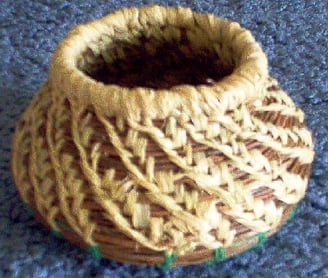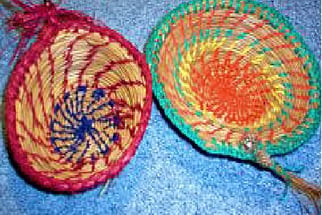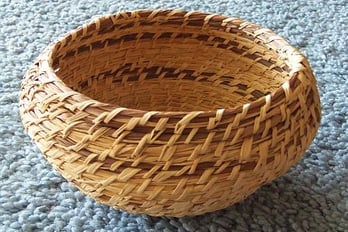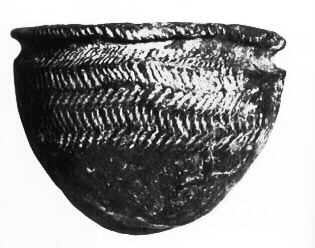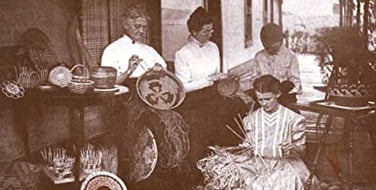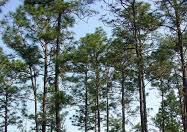Basketry
The art of making baskets dates back thousands of years ago to containers found in the Orient. Some of the stitches used today have an early Egyptian origin. A traditional style of basket of this time is what we refer to as a portable bassinet with handles, and is named the Baby Moses Basket. Originally these were made from reeds and grasses.
For other functional baskets, the materials used were determined by what was locally available. Typical binding materials were ferns and grasses, plant and tree fibers, sometimes twisted into rope and bound using needles fashioned from bones or shells.
Early American Indians are credited for the useful styles and methods we use today. From this came different techniques for hand weaving, fabrication of textiles, and the beginning of pottery using hand woven forms that burned away during the firing process. They were also known to have travel routes for trading baskets, blankets, and other handmade items. These are referred to as trading baskets. In recent time, more decorative style baskets have been made strictly for sale to tourists. These are referred to as tourist baskets.
This kit includes materials and directions for making pine needle baskets with a needle, stitch binding material of natural fibers; colorful thread, 2 bundles of pine needles and a bundle of raffia. There are techniques for shaping and illustrated diagrams of stitches. Along with instructions for natural material use and storage.
The Florida Slash pine also known as the Long leaf pine.
Above is an example of how a basket was first made and used as a form for making pottery before better techniques were discovered. The baskets were removed when the pottery was cured. In earlier times it was burned away as the clay vessel was fired for drying.
Modern pine needle basketry is noted to have begun during the Civil War times (1861-1865) when Mrs. M.J. McAfee of Southern Georgia used pine needles that she bound together with cotton thread to replace a worn hat for her father. She claimed to be the originator of pine needle basketry as we know it today.
American Indian Baskets
Basket-weaving is one of the oldest known Native American crafts--there are ancient Indian baskets from the Southwest that have been identified by archaeologists as nearly 8000 years old. As with most Native American art, there were originally multiple distinct basketry traditions in North America. Different tribes used different materials, weaving techniques, basket shapes, and characteristic patterns.
Seminole Indians of South Florida are noted to be the first pine needle basket makers. The Seminole Indians used a bone or shell needle to sew bundles of pine needles together with fern roots, sisal, or swamp grass. Some of the baskets were used for feed baskets, to carry water, and for winnowing seeds.
Northeast Indian baskets, for example, are traditionally made out of pounded ash splints or braided sweet grass. Cherokee and other Southeast Indian baskets are traditionally from bundled pine needles or river cane wicker. Southwestern Indians make baskets from tightly coiled sumac or willow wood, and Northwest Coast Indians typically weave with cedar bark, swamp grass, and spruce root. Northern Indian tribes like the Ojibwe and Dene craft birch bark baskets, and the Inuit even make whale baleen baskets (though this is a more recent tradition than the American Indian ones). As native people were displaced from their traditional lands and lifestyles, their traditional tribal basket weaving styles started to change somewhat as they adapted to new materials and absorbed the customs of new neighbors, and in places like Oklahoma where many tribes were interred together, fusion styles of basket weaving arose. However, unlike some traditional native crafts, the original diversity of Native American basket styles is still very much evident today.

